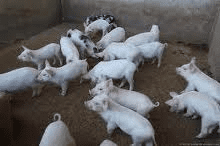US – An additional point regarding our packer gross margin estimates — A DLR reader quite correctly pointed out, after reading yesterday’s edition, that beef packer margins are not presently as good as the chart indicates because many packers had made "out-front" sales (ie. forward-priced product 2-6 months in advance) expecting lower-cost cattle by now, Steve Meyer and Len Steiner write.
The out-front prices were lower and today’s higher-cost of cattle has put some firms in a bind on at least a portion of their volume. The same could well be true of pork packers who looked at $90-plus cutouts back in June and probably thought they could not go a lot higher
This underlying issue is that analysts have no way of knowing how firms have behaved regarding timing of their sales or pricing or how much hedge protection they may have in place. Unless one has some real talent at discerning such matters based on hardly any data, one is forced to assume spot market purchasing and spot market selling. The same is true for estimating hog margins, cow-calf margins, back-grounding margins or feedlot margins. We authors just need to point out that limitation and let readers infer any deviation that their unique knowledge or information may imply.
Another reader posed a good question last week when she asked, "Where are we in the hog cycle?" The question may have been better stated, "Where is the hog cycle?" given US hog output fluctuations — or the lack thereof — of the past few years.
First some background. The hog cycle or the repetitive increases and decreases of output by hog producers is one of the most well-established, recognizable business cycles known. We are told that you can trace the cycle all the way back to the 1600s in England and it is readily apparent in US data back to the mid- 1800s. The cycle is caused by the roughly 1-year lag from breeding a sow to marketing a pig (driven by the pig’s reproductive cycle) and another lag (roughly 1 year) in the decision process of producers. That final lag is also dependent on the rate at which profits are accumulated (which either attracts new entrants or allows existing producers to expand) or money is lost (which drives contraction). The bottom line is that the hog cycle runs 3-4 years from peak to peak or bottom to bottom.
The chart below shows the cycle from 1970 to 2010 in percent change terms. Note that in the ‘70s, year-to-year changes of +/- 20 per cent were not unusual. But also note that the annual changes began to get smaller and smaller. The primary reasons for this flattening of the cycle were technology developments and consequent changes in industry structure.
Prior to the 1980s, there were still many hogs produced by firms that were "in" hogs when profits were good and “out” of hogs when they were not. They accounted for much of those +/- 20 per cent swings. But new technologies that reduced costs, allowed successful producers to raise and control more hogs and put both hogs and people indoors in more comfortable environments left little profit for higher-cost in-and-out producers. In addition, higher-cost, singlepurpose facilities are much more difficult to get out or production that a group of huts in a pasture. So, the cycle flattened (as evidenced by the decreasing standard deviations) to the point that there has been no real hog cycle since 2000. In fact, had it not been for the production enhancing impact of circovirus vaccines in 2007, this decade would probably not have seen a year-on-year change exceeding the 6.2 per cent of Q3 in 2002.
But the following chart shows clearly that price variation remains HUGE! Some swings have been driven by demand shifts (China in ‘08, H1N1 in ‘09) but it also appears that the elasticity of demand for live hogs has gotten smaller over time. A more inelastic demand means larger price swings for a specific level of supply change. "Steady-she-goes" output will likely serve producers well.
http://www.thepigsite.com/swinenews/27406/cme-hog-price-variation-remains-huge?


Deprecated: strpos(): Passing null to parameter #1 ($haystack) of type string is deprecated in /home/agriviek8Qv/agriviet.net/public_html/wp-includes/comment-template.php on line 2522